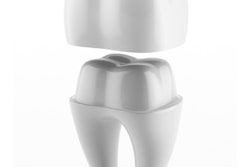
One question any office considering the purchase of a CAD/CAM system must ask is how much time will be saved during crown fabrication versus the traditional process.
The more efficient the fabrication process is, the more productive an office can be, allowing more patients to be scheduled and technicians to get more tasks completed. Researchers from Switzerland undertook a randomized clinical trial to measure if CAD/CAM systems were indeed less time-consuming than conventional methods when fabricating a single posterior crown. Their results were published in the Journal of Prosthetic Dentistry (December 23, 2016).
"Both chairside and laboratory CAD/CAM manufacturing procedures may increase the efficiency of the fabrication of dental restorations," the authors wrote. "Time-consuming manual fabrication steps, including waxing and casting or pressing, can now be delegated to the CAD/CAM software and machines."
The study was led by Irena Sailer, DDS, a professor in the division of fixed prosthodontics and biomaterials at the University Clinics for Dental Medicine at the University of Geneva.
Reduced production time
The benefits of a CAD/CAM system for a dental practice include reduced production time and increased efficiency in fabricating restorations. These systems are associated with a considerable financial investment, however, and dentists must consider the technology's amortization in any final purchase decision, the authors noted.
“Time-consuming manual fabrication steps, including waxing and casting or pressing, can now be delegated to CAD/CAM software and machines.”
One way to justify the purchase and use of CAD/CAM systems would be if they allowed practices to increase their productivity when it comes to restorations. To determine this, the researchers conducted a randomized clinical trial to compare the laboratory production time for tooth-supported single crowns made by four different digital workflows versus that of a conventional workflow. They also evaluated the treatment times needed to judge the clinical outcomes of the restorations.
The study included 10 participants who needed a single crown in the posterior region. The researchers fabricated a total of 50 monolithic crowns made of lithium disilicate-reinforced glass ceramic (IPS e.max CAD, Ivoclar Vivedent) for each participant. They fabricated a total of 40 posterior CAD/CAM crowns and 10 conventional crowns using five different manufacturing processes. Eight participants received a molar crown, and the other two a premolar crown. The researchers recorded the time for the fabrication of the casts and the crowns. Subsequently, they clinically evaluated the crowns and recorded the corresponding treatment times.
The four CAD/CAM systems used are listed below:
- Lava Chairside Oral Scanner C.O.S. version 3.0 (3M ESPE) CAD software and centralized CAM
- Cares Visual 6.2 (Straumann) CAD software and centralized CAM
- Cerec Connect CAD (Dentsply Sirona) software and lab site CAM
- Cerec Connect CAD (Dentsply Sirona) software with centralized CAM
The conventional fabrication included a wax pattern of the crown and heat pressing according to the lost-wax technique (IPS e.max Press, Ivoclar Vivedent).
The total mean active working times for the dental technician are shown in the chart below, along with the standard deviation in minutes. The Cerec Connect CAD with lab site CAM group had the least total working time at 74 ± 5 minutes, while the conventional fabrication group doubled that time, coming in at 148 ± 11 minutes. The authors also reported that statistical differences in time for the clinical evaluation were found among groups, indicating similar outcomes.
| Dental technician working time with CAD/CAM in minutes | |||||||
| Group | Fabrication | Before evaluation | After evaluation | Total working time | |||
| Cast design | Cast delivery | Crown design | Crown delivery | Finalization | Waiting time | ||
| Lava C.O.S. | 8 ± 1 | 5085 ± 387 | 16 ± 1 | 4854 ± 247 | 64 ± 6 | 45 | 88 ± 6 |
| Cares Visual | 1 ± 0.5 | 5605 ± 251 | 10 ± 1 | 5794 ± 420 | 63 ± 11 | 45 | 74 ± 12 |
| Cerec Connect CAD with lab side CAM | 2 ± 0.3 | No physical cast | 11 ± 2 | 16 ± 1 | 62 ± 5 | 45 | 74 ± 5 |
| Cerec Connect CAD with centralized CAM | 2 ± 0.3 | 5356 ± 415 | 14 ± 2 | 5296 ± 606 | 76 ± 5 | 45 | 92 ± 8 |
| Conventional fabrication | 26 ± 3 | 120 | 71 ± 11 | 149 ± 2 | 50.3 ± 3 | 45 | 148 ± 11 |
Overall working time
The authors noted the reduced times associated with in-office procedures. They also acknowledged that CAD/CAM technology, like any computerized technology, is constantly improving and that their results are limited to the software version used.
"Irrespective of the CAD/CAM system, the overall laboratory working time for a digital workflow was significantly shorter than for the conventional workflow, since the dental technician needed less active working time," the authors concluded.
Study disclosures
The study was supported by the Clinic of Fixed and Removable Prosthodontics and Dental Material Science at the Center of Dental Medicine at the University of Zurich in Switzerland and by a research grant from Institut Straumann in Basel, Switzerland.



















